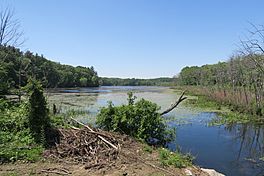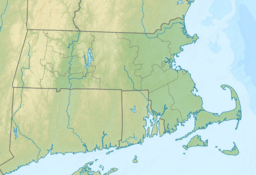Hocomonco Pond facts for kids
Quick facts for kids Hocomonco Pond |
|
|---|---|

Hocomonco Pond
|
|
| Location | Westborough, Massachusetts |
| Coordinates | 42°16′21″N 71°38′58″W / 42.27250°N 71.64944°W |
| Type | Pond |
| Basin countries | United States |
| Surface area | 27 acres (11 ha) |
| Surface elevation | 276 ft (84 m) |
| Superfund site | |
| Information | |
| CERCLIS ID | MAD980732341 |
| Contaminants | Creosote |
| Progress | |
| Proposed | December 30, 1982 |
| Listed | September 8, 1983 |
| Construction completed |
September 22, 1999 |
| List of Superfund sites | |
Hocomonco Pond is a fun place for recreation in Westborough, Massachusetts. It is located near Route 9. People sometimes call it Hobomoc Pond. This name comes from Hobomok, who was an evil spirit in the stories of the Wamesit Indian people. This pond and the land around it are part of a special cleanup program called a Superfund site.
What is a Superfund Site?
A Superfund site is a place that has been polluted with dangerous chemicals. The United States government, through the Environmental Protection Agency (EPA), identifies these sites. They then work to clean them up to protect people and the environment. Hocomonco Pond became a Superfund site on September 8, 1983.
Why Hocomonco Pond Needed Cleaning
From the 1930s to the 1940s, a factory operated near the pond. This factory treated wood products like telephone poles and railroad ties. They used a chemical called creosote to preserve the wood. Creosote is a dark, oily liquid that helps wood last longer.
During the wood treatment process, extra creosote and waste liquids were put into an unlined pit. This pit was called the "former lagoon." The creosote then soaked into the soil, sediments, and groundwater around the pond. Creosote contains harmful chemicals that can be bad for health.
In the 1970s, a storm drain was built near the pit. This drain carried the polluted liquids directly into Hocomonco Pond. This made the pond and its surrounding area contaminated.
How Hocomonco Pond Was Cleaned Up
In 1985, a plan was made to clean up the site. This plan outlined specific steps to remove the pollution.
First, a special landfill was built at the old pit area. This landfill was designed to safely hold the contaminated materials. The storm drain that carried pollution to the pond was also moved.
Workers then dug up and removed the polluted soil, waste, and sediments. This cleanup work was finished in 1996. After the contaminated materials were removed, the old pit area was covered with a special cap. This cap helps to keep any remaining pollution from spreading. Even after the cleanup, the groundwater in the area still has some contamination.



